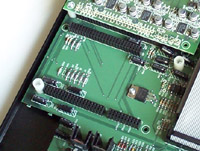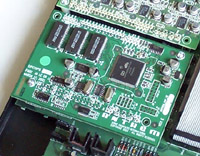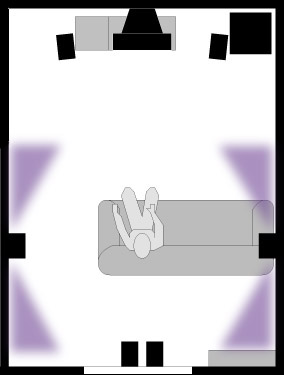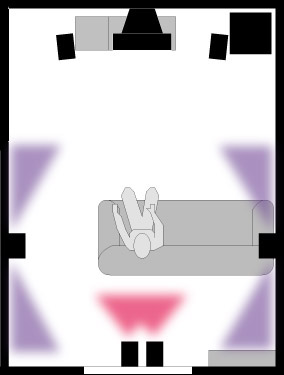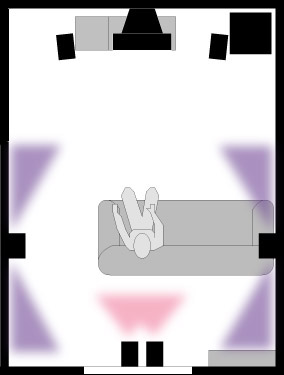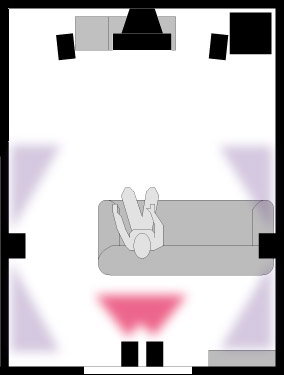|
|||||||||||||||||||||||||||||||
Upgrade Reality "Upgrade" is not a new word to the AV world, but its meaning is clouded at best. In the analogue tweak days "upgrade" meant replacing a capacitor or tube, but since the advent of surround sound processing in the digital domain, the consumer's expectation of "upgrade" and the manufacturer's definition can often be at odds. There is no standard. It's open to interpretation. Some brands interpret "upgrade" as being something as narrow as adding an outboard box of some sort. Not very reassuring. The definitive statement of SSP upgradablility is the proverbial "Card Cage" chassis which is even more modular in principal than a PC clone: A simple, passive back plane ties multiple boards together, each representing only one part of the whole: Some boards are just pre-outs, some are just digital-in, and some are just CPU/DSP power. Sounds good doesn't it? Sure. It will cost you though. Dearly. When we first reported on the Anthem AVM-20, we noted that its approach to the upgrade concept is just about the best you can get without going the card cage route. On the one hand, everything from a functional point of view is in software, permitting VERY easy changes, fixes, and additions. Anthem demonstrated not only the practicality of this, but also their commitment to the AVM-20's life span when they released the 1.10 software revision late last year. Group functions for the AVM-20 are separated as much as possible, giving you such things as a replaceable board with all the DACs and ADCs and another with the DSP CPU and its ROMs. This last item is where today's story begins. The AVM-20 2.0 The next phase for the AVM-20 was slated to incorporate THX Ultra2 processing as well as Dolby Pro Logic II (DPL-II) decoding, among other new amenities. These last functions simply could not be done with the original CPU, so here we are almost a year after our first review, replacing the DSP board and effectively changing the face of Secrets' 2001 SSP of the Year. Officially, end users will not be doing this upgrade themselves, as it involves getting inside the chassis. It's not a complicated job, but you really need to know just how much force to apply and where. While the Paradigm Group did offer to swap our original review unit with a newly made 2.0 version, we insisted we do the upgrade on the original, just for the record, to show you there aren't any smoke and mirrors. So, we removed the chassis cover, pulled the old board, and replaced it with the new one (photos shown below). No big deal, but you have to be careful.
Next we flashed the new software (1.90l beta at the time) and there you have it. A new AVM-20. THX Ultra2 Out of a demand for a single 7.1 setup which would satisfy "real" EX sound tracks as well as non-encoded 5.1 movies AND music, THX Ultra2 builds on their Ultra spec by adding two new playback modes in concert with a couple of new processes, all of which are focused on a 7.1 channel setup. The new setup still uses main speakers with demanding performance specs, vertical directivity, and a natural 2nd order roll-off at 80 Hz. The surround speakers are still dipole. The rears however are monopoles, intentionally placed right next to each other, and the subwoofer must now extend down to 20 Hz without its response disappearing into the netherworld. (We interviewed THX on video tape at CEDIA, and they explained Ultra2 in detail. This interview will be published here shortly.) The two new rear speakers are the key. With them comes a new process called ASA or Advanced Speaker Array. This proprietary process not only addresses the potential phase issues of two adjacent speakers, but tailors what comes out of them to meet to goal of the various modes.
The new modes become available only if you've configured the AVM-20 for rear speakers (naturally), and there are a few new settings to adjust: Rear speaker separation - You tell the AVM-20 how far apart the two speakers are. Ultra2 Subwoofer - You tell the AVM-20 if you have an Ultra2 Subwoofer. An Ultra2 certified subwoofer differs from an Ultra certified one in that its extension is flat to 20 Hz (the old spec was flat to 35 Hz and then rolled off at 12dB/octave). This setting only serves to enable/disable the next setting below.. Boundary Compensation On/Off - If you have an Ultra2 Sub, and you are seated close to a wall or if the sub is getting too much reinforcement from corner placement, this setting attenuates the very bottom of its output to compensate. Not wanting to turn this article into an Ultra2 debate, I will simply say I verified the AVM-20's implementation of it (which meets spec). When demonstrated to me (by THX themselves) in Las Vegas, it sounded pretty darn good, but I've heard murmurs that end users aren't too crazy about it, so you're mileage may vary. Note that, as before, the AVM-20 can digitize the 5.1 analogue input for processing (bass management mostly), so it can now apply THX Ultra2 Music to DVD-Audio material. Cool! THX on the AVM-20 is more of a toggle as opposed to distinct modes. It's perhaps best to think of it as an overlay: Turn it on, and it gets added to the current playback mode (and limits you to modes valid for THX post processing). So for example with a 2-channel source and THX on, the modes available are limited to Pro Logic, Pro Logic II Movie, and DTS Neo:6 Cinema. For any 5.1 soundtrack (be it Dolby Digital, DTS, or the 5.1 analogue input), when the system is configured for 7.1 speakers, with THX on, you select from among THX Cinema, THX Surround EX, Ultra2 Cinema, and Ultra2 Music. Modes a Plenty Quite possibly the single "valid" gripe about the AVM-20 has now been put to rest. Held back due to a limitation in the (at that time) available Motorola chips, Pro Logic II is now on the menu, and all the optional adjustment parameters for Pro Logic II Music are available to the user. For a detailed look at Pro Logic II, please visit our original Pro Logic II Report. In light of the dramatically effective Pro Logic II Music, which I now use to the TOTAL exclusion of good ol' Stereo, Anthem has dropped the "acoustical environments" (Hall, Jazz Club, Church, etc.) from the menu. I know I didn't use them before, and apparently neither did the vast majority of customers. Also new are Anthem's own matrix decoders, AnthemLogic Cinema and AnthemLogic Music, replacing the previous mode, CinemaLogic (which despite its name was really well suited to music but not movies). Also new is DTS Neo:6 Music and DTS Neo:6 Movie, neither of which I'm particularly fond of (see also our original Pro Logic II Report). As a recent 'answer' to Pro Logic II Music's Center Width adjustment, they've now come up with CGAIN (which is more clearly described as "Center Image"), and the AVM-20 is among the first to offer it to the user. To complete the DTS licensing suite, DTS ES Discrete has also been added to the repertoire. Dolby Digital EX is available now if users so choose. Dolby Digital EX differs only from THX Surround EX in that it does not include the basic THX Post Processes (Re-Eq, Timber Matching, and Adaptive De-correlation). Because the AVM-20 already lets you engage or disengage Re-Eq at whim, I see no reason to forgo the other beneficial THX processes . . . but to each his own. Because my room has been specifically designed to be on the dry side, it intentionally relies 100% on the 5.1 array for environmental ambiance. Stereo is a thing of the past for me. Pro Logic II is now prominent on all new processors and receivers, but there are music tracks which sound a little too lively on it. The best overall mode for music? Ironically: AnthemLogic Cinema. Also new to the AVM-20 is Academy Mono. This mono-only mode sums everything to center and applies the Academy Curve (characterized as a dramatic roll-off of the treble and attenuation of the low end). This mode is particularly suited for unaltered mono movie soundtracks made prior to the mid 1970s. For more information, please see our article Learning from History: Cinema Sound and EQ Curves. Bass Management Anthem is to be commended: They actually listen when customers talk. The AVM-20 is credited as being the culmination of feedback from dealers, custom installers, and especially owners of the original non-THX AVM-2. For the most part, there could not be a more symbiotic relationship between manufacture and end user than to "give the people what they want". The number one requested feature put to Anthem since the AVM-2 first hit shelves was separate, independent crossover frequencies for the various speakers. Now Anthem has, at customers' demand, added this with 2.0. You can set the crossover point for Front L/R, Center , Surround L/R, and Rear R/L different from each other. In consequence you must now also set the low-pass for the subwoofer. The range of valid settings has been widened to 25 Hz through 160 Hz, and the increments refined to 5 Hz. Anyone who read my review of the AVM-20 will likely have noted I praised the omission of this feature. Not wanting to bog down this review with a tangent, for those interested in my take on it, Colin and I have written a short essay on the subject. Additional new bass management items include a variable phase adjustment for the sub in case it doesn't already have one (50 increments) as well as a polarity flip option. Conclusions Lightning strikes twice. Anthem has taken an incredibly complete Surround Sound Processor and brought it right up to date, refining the selection of playback modes. I cannot think of a reason existing owners would not spend the few hundred bucks on the DSP board upgrade (which has a higher horsepower DSP chip) to take advantage of the 2.0 software. It does not end here. I have every confidence in Anthem to refine this product even further through future software revisions. While thousands have enjoyed their AVM-20 for almost a year now, to those who were on the fence "waiting for the upgrade", your days of postponing SSP bliss are over!
-
Brian Florian -
|
|||||||||||||||||||||||||||||||



